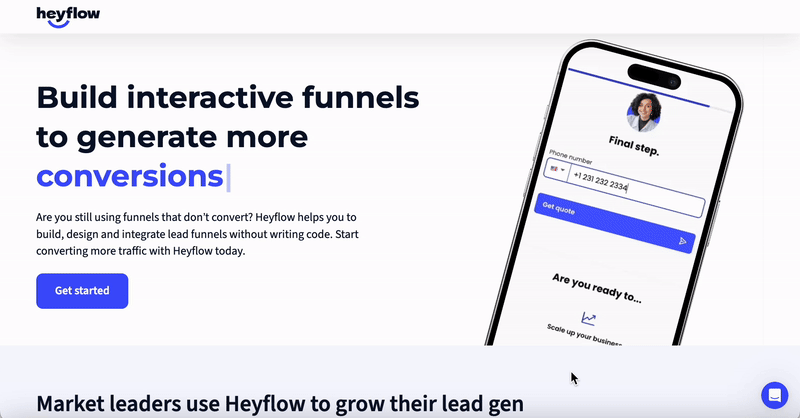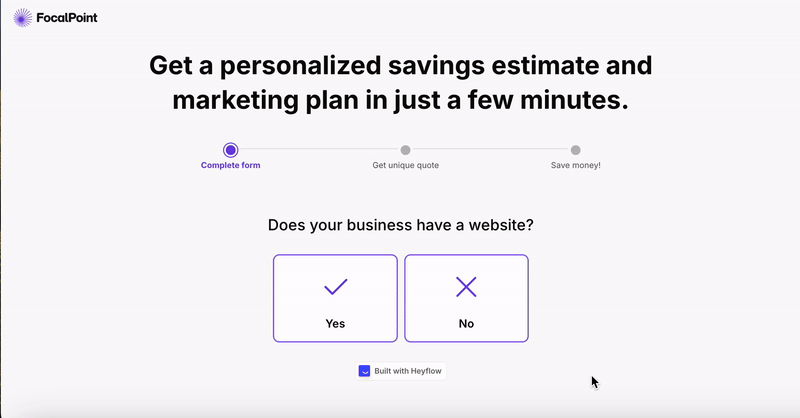Marketing fundamentals
View all articlesWhat is a conversion rate and how to calculate it to maximize your leads

Conversion rates are key marketing metrics with helpful insights for the success of your business. Getting website visitors is like going on a first date, but conversion rates measure how many actually call back for a second one.
In this article, you’ll learn what a conversion rate in marketing is, how to calculate it, and ways to optimize it. Let’s see what it takes to turn curious website visitors into converted, loyal customers (and get that second date).
What is a conversion rate in marketing?
A conversion is any action that directly contributes to a business goal, such as moving a potential customer closer to becoming a paying or loyal user. A conversion rate tells you how successful your company’s digital marketing is at driving conversions. It measures the percentage of people who take a desired action after interacting with your business. This interaction can happen through marketing campaigns, landing pages, or a web form.
It applies to various actions, like signing up for a newsletter, submitting a subscription form, or clicking a link – not just purchases!
Examples of conversions:
SaaS: Signing up for a free trial
E-commerce: Making a purchase
Lead generation: Filling out a contact form
Content marketing: Subscribing to a newsletter
Social media: Clicking on an ad or following a page

How do you calculate your conversion rate?
To calculate your conversion rate, divide the number of conversions by the total number of visitors.
Conversion rate formula:

For example, if 10 people buy from your website out of 200 visitors:
(10 ÷ 200) × 100 = 5% conversion rate
So… is that good?
A good conversion rate depends on your industry, traffic source, and type of conversion (e.g., purchases, sign-ups, downloads). Here are some general benchmarks:
E-commerce purchase: 2%–3% is average, 5%+ is excellent.
B2B lead generation: 2.5%–5% is common, 10%+ is outstanding.
Landing page opt-in: 5%–15% is typical, but top-performing pages can hit 20%+.
SaaS free trial to paid subscription: 3%–7% is standard, 10%+ is strong.
Here’s a graph to show you where your happy place is:

If you find yourself somewhere in the red, it’s time to talk optimization.
What is conversion rate optimization?
Conversion rate optimization (CRO) is the process of improving a website, landing page, or marketing campaign to increase the number of conversions. Think of it as the debrief with a good friend after a bad first date. It’s a safe place— share what went wrong! There’s nowhere to go but up, and optimization is here to help.
Just as hashing it out with a good friend can help you pick your game up, so can conversion rate optimization. It involves analyzing user behavior, testing different strategies, and using conversion data to enhance engagement and drive more successful actions, such as purchases or sign-ups.
*Cue sound of your inbox filling up.
How do you increase conversion rates?
From simplifying the user journey to utilizing A/B testing, follow lead generation best practices to convert potential customers into paying customers. Let’s explore five steps to boost your conversion rate.
1. Implement multi-step forms
Multi-step forms boost conversion rates by breaking down long forms into user-friendly steps, reducing user fatigue and increasing engagement. HubSpot saw the importance early on and reported in 2020 that multi-step forms deliver an 86% higher conversion rate compared to single-step forms. No wonder it’s one of the key steps to creating an interactive website.
Unlike single-step forms, which can feel overwhelming, multi-step forms guide users through the process, improving completion rates.

This Heyflow B2B lead generation template uses simple navigation, clean and clear design, and user-friendly journey conversion rate optimization strategies. Ah, if only the dating world were as easy to navigate.
2. Consider the target audience
High-quality content not only drives traffic to your site but also nurtures leads by addressing their needs and pain points. To do that, you’ll have to get to know your target audience. Then, design your content around that research.
Ask the following questions:
Who is the target audience?
How would we best connect with them?
What types of industries will our readers come from?

This example from Social Native, a social recruitment company, addresses their target audience directly on their landing page. They offer content geared towards their unique visitors.
3. Create insightful content
While they’re great, catchy banners and good-looking landing pages aren’t enough. To increase conversion rates, you need insightful content that:
Showcases your company’s industry expertise
Builds customer’s trust
Keeps visitors engaged

This landing page example from Future Labs provides ample useful and relevant information that is easily accessible to website visitors.
By providing valuable insights, you can generate more interest, encourage action, and turn visitors into loyal customers— win!
4. Include an effective call to action (CTA)
An effective CTA grabs attention and clearly guides users toward the next step. It creates urgency and reduces hesitation, making it easier for visitors to take action. A well-placed, compelling CTA can significantly boost conversion rates by turning interest into engagement.
For instance, one marketing expert was able to increase conversions by 304% just by changing the placement of a CTA on a landing page. Using the steps you’ve learned this far in the process, you’ll be able to grab the attention of the visitor and provide an actionable CTA, leading users to the desired action.

This landing page from Jacobs Kaffee places an inviting CTA after its mission statement, utilizing user-friendly navigation and concise copy to drive user experience.
5. A/B test
A/B testing helps optimize conversion rates by allowing you to compare different versions of a flow and identify what resonates best with users. With Heyflow, there are many things you can A/B test like CTAs buttons, layouts, form fields, and more to improve conversion rate.
The benefit of digital marketing is that you can adjust for higher conversion rates by utilizing tracking and testing tools. In the example above, Heyflow demonstrates how to use A/B testing on this SaaS website.
This method helps you to identify areas for improvement to drive customers to a specific desired action based on the conversion rate for each sample. Here, the desired action is to get the website visitors to book a demo.
Why is conversion rate optimization important in marketing?
CRO makes marketing more efficient – maximizing results without increasing advertising spending. A higher conversion rate means more leads, better-quality customers, and increased revenue.
Since conversion rate directly measures how well your marketing turns visitors into buyers, it’s one of the most accurate performance indicators. Optimizing conversions ensures you get the most out of every marketing dollar while reaching the right audience effectively.
CRO is a way of taking feedback and using it to create a better return on your investment.
The conversion rate bite-sized breakdown
Since you know what a conversion rate is, how to calculate it, and steps for conversion rate optimization, it’s time to put it into practice. But don’t worry, you’re not alone in this.
Heyflow’s zero-code platform was designed with conversion rates in mind. Boost your business’s number of conversions with the help of user-friendly webforms, attractive landing pages, and analytic tools – all with friendly customer service ready to help your business soar.
Second date, on!
----------------
Turn visitors into leads
With Heyflow, designing optimized forms is easier than ever. Drive better conversion rates and create seamless experiences that turn interest into action—all without writing a single line of code.



